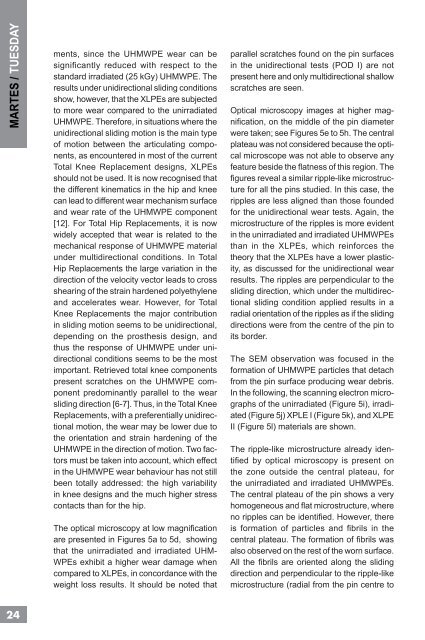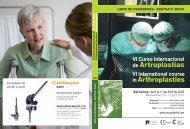cadera / hip - Active Congress.......
cadera / hip - Active Congress.......
cadera / hip - Active Congress.......
You also want an ePaper? Increase the reach of your titles
YUMPU automatically turns print PDFs into web optimized ePapers that Google loves.
MARTES / TUESDAY<br />
24<br />
ments, since the UHMWPE wear can be<br />
significantly reduced with respect to the<br />
standard irradiated (25 kGy) UHMWPE. The<br />
results under unidirectional sliding conditions<br />
show, however, that the XLPEs are subjected<br />
to more wear compared to the unirradiated<br />
UHMWPE. Therefore, in situations where the<br />
unidirectional sliding motion is the main type<br />
of motion between the articulating components,<br />
as encountered in most of the current<br />
Total Knee Replacement designs, XLPEs<br />
should not be used. It is now recognised that<br />
the different kinematics in the <strong>hip</strong> and knee<br />
can lead to different wear mechanism surface<br />
and wear rate of the UHMWPE component<br />
[12]. For Total Hip Replacements, it is now<br />
widely accepted that wear is related to the<br />
mechanical response of UHMWPE material<br />
under multidirectional conditions. In Total<br />
Hip Replacements the large variation in the<br />
direction of the velocity vector leads to cross<br />
shearing of the strain hardened polyethylene<br />
and accelerates wear. However, for Total<br />
Knee Replacements the major contribution<br />
in sliding motion seems to be unidirectional,<br />
depending on the prosthesis design, and<br />
thus the response of UHMWPE under unidirectional<br />
conditions seems to be the most<br />
important. Retrieved total knee components<br />
present scratches on the UHMWPE component<br />
predominantly parallel to the wear<br />
sliding direction [6-7]. Thus, in the Total Knee<br />
Replacements, with a preferentially unidirectional<br />
motion, the wear may be lower due to<br />
the orientation and strain hardening of the<br />
UHMWPE in the direction of motion. Two factors<br />
must be taken into account, which effect<br />
in the UHMWPE wear behaviour has not still<br />
been totally addressed: the high variability<br />
in knee designs and the much higher stress<br />
contacts than for the <strong>hip</strong>.<br />
The optical microscopy at low magnifi cation<br />
are presented in Figures 5a to 5d, showing<br />
that the unirradiated and irradiated UHM-<br />
WPEs exhibit a higher wear damage when<br />
compared to XLPEs, in concordance with the<br />
weight loss results. It should be noted that<br />
parallel scratches found on the pin surfaces<br />
in the unidirectional tests (POD I) are not<br />
present here and only multidirectional shallow<br />
scratches are seen.<br />
Optical microscopy images at higher magnifi<br />
cation, on the middle of the pin diameter<br />
were taken; see Figures 5e to 5h. The central<br />
plateau was not considered because the optical<br />
microscope was not able to observe any<br />
feature beside the fl atness of this region. The<br />
fi gures reveal a similar ripple-like microstructure<br />
for all the pins studied. In this case, the<br />
ripples are less aligned than those founded<br />
for the unidirectional wear tests. Again, the<br />
microstructure of the ripples is more evident<br />
in the unirradiated and irradiated UHMWPEs<br />
than in the XLPEs, which reinforces the<br />
theory that the XLPEs have a lower plasticity,<br />
as discussed for the unidirectional wear<br />
results. The ripples are perpendicular to the<br />
sliding direction, which under the multidirectional<br />
sliding condition applied results in a<br />
radial orientation of the ripples as if the sliding<br />
directions were from the centre of the pin to<br />
its border.<br />
The SEM observation was focused in the<br />
formation of UHMWPE particles that detach<br />
from the pin surface producing wear debris.<br />
In the following, the scanning electron micrographs<br />
of the unirradiated (Figure 5i), irradiated<br />
(Figure 5j) XPLE I (Figure 5k), and XLPE<br />
II (Figure 5l) materials are shown.<br />
The ripple-like microstructure already identifi<br />
ed by optical microscopy is present on<br />
the zone outside the central plateau, for<br />
the unirradiated and irradiated UHMWPEs.<br />
The central plateau of the pin shows a very<br />
homogeneous and fl at microstructure, where<br />
no ripples can be identifi ed. However, there<br />
is formation of particles and fi brils in the<br />
central plateau. The formation of fi brils was<br />
also observed on the rest of the worn surface.<br />
All the fi brils are oriented along the sliding<br />
direction and perpendicular to the ripple-like<br />
microstructure (radial from the pin centre to





